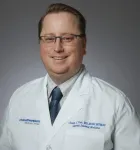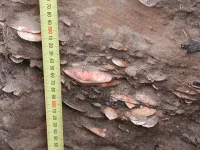Light, in addition to ocean temperature, plays role in coral bleaching
University of Guam researchers have found that shade can mitigate the effects of heat stress on corals
2021-04-29
(Press-News.org) A study by University of Guam researchers has found that shade can mitigate the effects of heat stress on corals. The study, which was funded by the university's National Science Foundation EPSCoR grant, was published in February in the peer-reviewed Marine Biology Research journal.
"We wanted to see what role light has in coral bleaching," said UOG Assistant Professor Bastian Bentlage, the supervisor and co-author of the study. "Usually, people talk about temperature as a cause for bleaching, but we show that both light and temperature work together."
Previous UOG research led by Laurie J. Raymundo found that more than one-third of all coral reefs in Guam were killed from 2013 to 2017 over the course of multiple bleaching events. Coral bleaching is the process in which corals stressed by environmental changes expel the essential symbiotic algae that live in their tissues, causing them to turn white and often die.
This latest study examined the resilience of staghorn corals (Acropora cf. pulchra) in heightened seawater temperatures. This species of coral is one of Guam's dominant reef-builders, and its habitats experience temperatures up to 97 degrees Fahrenheit during the hottest months of the year, leaving it vulnerable to bleaching episodes and population decline.
A team of researchers -- including lead author Justin T. Berg, a UOG graduate student studying biology; Charlotte M. David, an undergraduate student from the University of Plymouth (England), and Melissa Gabriel, a UOG graduate student studying environmental science -- took coral samples from the Hagåtña reef flat and examined their health in the UOG Marine Laboratory under normal and elevated temperatures.
"One group was subjected to consistent baseline temperatures observed on Guam's reef flats," Bentlage said, "and another was set to temperatures that are projected to become the new normal over the next couple of decades."
The researchers found that the corals took three weeks to recover from a week-long heat stress event. The experiment was then replicated to see how the corals would react if they were given shade while subjected to warmer temperatures.
"We found that when we put the shading over coral with increased seawater temperatures, it greatly increased photosynthetic yield of the symbiotic algae. Shade made a huge difference for coral health when you have high temperatures," Berg said.
Implications for reef management
Shading is a practice already used in coral nurseries, Bentlage said, but it may not be practical to shade whole reefs in the ocean. Future studies can look into practical ways to reduce the impact of light on corals, particularly as they recover from periods of elevated temperatures.
"We saw the corals recover rather slowly," Berg said. "The length of recovery indicates that corals are vulnerable during this time and management efforts may be particularly necessary during this period to reduce coral mortality."
Berg said the new knowledge may also help inform the best locations to successfully outplant corals.
"For example, slightly turbid waters could provide some shading to corals, making them less likely to bleach during periods of elevated sea surface temperatures," Berg said.
INFORMATION:
The study can be read in its entirety at https://doi.org/10.1080/17451000.2021.1875245.
[Attachments] See images for this press release:

ELSE PRESS RELEASES FROM THIS DATE:
2021-04-29
COLUMBUS, Ohio - Hispanic Americans have died of COVID-19 at a disproportionately high rate compared to whites because of workplace exposure to the virus, a new study suggests.
It's widely documented that Hispanics are overrepresented among workers in essential industries and occupations ranging from warehousing and grocery stores to health care and construction, much of which kept operating when most of the country shut down last spring.
The analysis of federal data showed that, considering their representation in the U.S. population, far higher percentages of Hispanics of working ...
2021-04-29
New Haven, Conn. -- Researchers at Yale and Princeton say the scientific community sorely needs a new way to compare the cascading effects of ecosystem loss due to human-induced environmental change to major crises of the past.
For too long, scientists have relied upon metrics that compare current rates of species loss with those characterizing mass extinctions in the distant past, according to Pincelli Hull, an assistant professor of Earth and planetary sciences at Yale, and Christopher Spalding, an astrophysicist at Princeton.
The result has been projections of extinction rates in the next few decades that are on the order ...
2021-04-29
DALLAS - April 28, 2021 - Depression screening among cancer patients improved by 40 percent to cover more than 90 percent of patients under a quality improvement program launched by a multidisciplinary team at UT Southwestern Medical Center and Southwestern Health Resources.
Cancer patients with depression are at an increased risk of mortality and suicide compared with those without depression. Although rates vary based on cancer type and stage, depression is estimated to affect 10 to 30 percent of patients with cancer compared with 7 to 8 percent of adults without a diagnosis or history of cancer, and impact both men and women equally.
Due to the higher risk, medical ...
2021-04-29
LAWRENCE -- For thousands of years during the last ice age, generations of maritime migrants paddled skin boats eastward across shallow ocean waters from Asia to present-day Alaska. They voyaged from island to island and ultimately to shore, surviving on bountiful seaweeds, fish, shellfish, birds and game harvested from coastal and nearshore biomes. Their island-rich route was possible due to a shifting archipelago that stretched almost 900 miles from one continent to the other.
A new study from the University of Kansas in partnership with universities in Bologna and Urbino, Italy, documents the newly named Bering Transitory Archipelago and then points to how, when and where the first Americans ...
2021-04-29
NEW YORK, NY (April 29, 2021)--A new study is drawing the most detailed picture yet of SARS-CoV-2 infection in the lung, revealing mechanisms that result in lethal COVID-19, and may explain long-term complications and show how COVID-19 differs from other infectious diseases.
Led by researchers at Columbia University Vagelos College of Physicians and Surgeons and Herbert Irving Comprehensive Cancer Center, the study found that in patients who died of the infection, COVID-19 unleashed a detrimental trifecta of runaway inflammation, direct destruction and impaired regeneration of lung cells involved in gas exchange, and accelerated lung scarring.
Though the study looked at lungs from patients who had died of the disease, ...
2021-04-29
Primary care practitioners often over-estimate the likelihood of a patient having a medical condition based on reported symptoms and laboratory test results. Such overestimations can lead to overdiagnosis and overtreatment, according to a recent study conducted by researchers at the University of Maryland School of Medicine (UMSOM) published in JAMA Internal Medicine.
"A large gap exists between practitioner estimates and scientific estimates of the probability of disease," said study leader Daniel Morgan, MD, a Professor of Epidemiology & Public Health at UMSOM. "Practitioners who overestimate ...
2021-04-29
The discovery of ancient kumara pits just north of Dunedin dating back to the 15th century have shone a light on how scientific evidence can complement mātauranga Maori around how and where the taonga were stored hundreds of years ago.
A new study published in the science journal PLOS ONE reports that early Polynesians once stored kumara - American sweet potato - in pits dug into sand dunes at Purākaunui, eastern Otago, less than 30km north of Dunedin. The pits were first discovered in 2001 and are found over 200km south of the currently accepted South Island limit of cooler-climate Māori kumara storage.
These Purākaunui features have the novel form of semi-subterranean, rectangular pits used for the cool seasonal storage ...
2021-04-29
The brain possesses a complex architecture of functional networks as its information-processing machinery. Is the brain's network architecture itself a target of disease? If so, which networks are associated with which diseases? What can this tell us about the underlying causes of brain disorders?
Building on the extraordinary progress in neuroscience made over the past 30 years, researchers from The University of Texas Health Science Center at San Antonio (UT Health San Antonio) published a study of 43 brain disorders - both psychiatric and neurologic - and strongly affirmed ...
2021-04-29
EUGENE, Ore. -- April 29, 2021 -- An analysis of Twitter activity between March 1 and Aug. 1, 2020, found strong support by U.S. users for wearing face coverings and that a media focus on anti-mask opinions fueled the rhetoric of those opposed, report University of Oregon researchers.
The study, published April 28 in the journal PLOS ONE, initially focused on linguistics, zeroing in on the language associated with hashtags during the study period, which began a month before the Centers for Disease Control and Prevention recommended mask-wearing to protect against COVID-19 infection.
However, to better understand that semantics, which were found to be polarized, angry and emotionally ...
2021-04-29
Adult mantis shrimp pack an explosive punch that can split water, but no crustacean emerges fully formed. Minute larvae can undergo six or seven transformations before emerging as fully developed adults and limbs and manoeuvres develop over time. So, when do mantis shrimp larvae acquire the ability to pulverise their dinner and how powerful are the punches that these mini crustaceans pack? 'We knew that larval mantis shrimp have these beautiful appendages; Megan Porter and Eve Robinson at the University of Hawaii had captured normal videos of a couple of strikes a few years ago', says Jacob Harrison from Duke University, USA. So, he packed up ...
LAST 30 PRESS RELEASES:
[Press-News.org] Light, in addition to ocean temperature, plays role in coral bleaching
University of Guam researchers have found that shade can mitigate the effects of heat stress on corals



